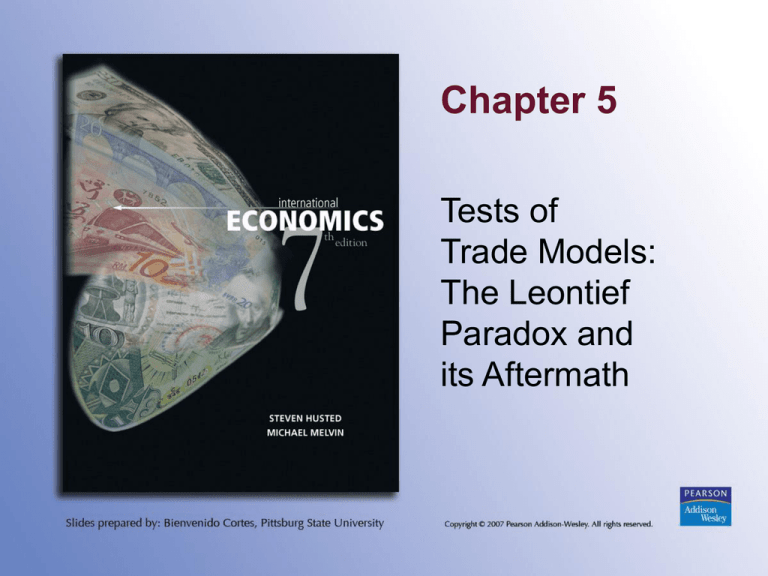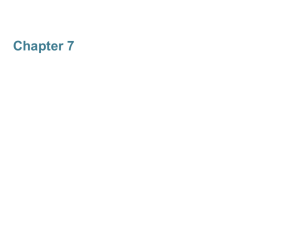
Chapter 5
Tests of
Trade Models:
The Leontief
Paradox and
its Aftermath
Topics to be Covered
•
•
•
•
•
•
•
•
•
•
Test of the Classical Model
Tests of the Heckscher-Ohlin Model
Leontief Paradox
Reconciliations of Leontief’s Findings
More Tests of the HO Model
Human Skills Theory
Product Life Cycle Theory
Similarity of Preferences Theory
Intra-industry Trade
Increasing Returns and Imperfect Competition
Copyright © 2007 Pearson Addison-Wesley. All rights reserved.
5-2
Test of the Classical Model
• G.D.A. MacDougall (1951)
• U.S. and U.K. exports and labor productivity
data for 25 industries in 1937
• Hypothesis: Since U.S. wages were twice
U.K. wages, then U.S. will have comparative
advantage in those industries where U.S.
labor is more than twice as productive as
U.K. labor.
• Finding: Hypothesis supported in 20 out of
25 industries.
Copyright © 2007 Pearson Addison-Wesley. All rights reserved.
5-3
Criticisms of the MacDougall Study
• Used U.S. and U.K. trade with rest
of the world instead of U.S.-U.K.
bilateral trade
• HO theory can also explain results
• Ignored other variables such as
transport costs, product differentiation,
and trade barriers
Copyright © 2007 Pearson Addison-Wesley. All rights reserved.
5-5
Test of the Heckscher-Ohlin Model
• W. Leontief (1951)
• Built input-output model for 200 U.S.
industries for 1947
• Assumed U.S. was the most Kabundant country
• Used U.S. exports and import
substitutes
Copyright © 2007 Pearson Addison-Wesley. All rights reserved.
5-6
Input-Output Table
• A table that details the sales of each industry
to all other industries in an economy.
• A spreadsheet with column entries showing
purchases made by a specific industry
from all other sectors, and row entries
showing sales by a specific industry to all
other sectors.
• Also contains the labor and capital
requirements for a fixed amount of output of
a given industry.
Copyright © 2007 Pearson Addison-Wesley. All rights reserved.
5-7
Leontief’s Test and Results
• Hypothesis: Since U.S. is K-abundant, the K/L
idled by a $1 million reduction in exports
would exceed the K/L required to produce $1
million of import substitutes.
• Results:
Reducing U.S. exports by $1 million idled $2.6
million in K and 182.3 years per worker.
Replacing $1 million of imports required $3.1
million in K and 170 years per worker.
Copyright © 2007 Pearson Addison-Wesley. All rights reserved.
5-8
Leontief Paradox
• The finding that U.S. exports tend to be
more labor-intensive than U.S. imports,
while U.S. imports are relatively more
capital-intensive than U.S. exports.
Copyright © 2007 Pearson Addison-Wesley. All rights reserved.
5-9
Reconciliations
of the Leontief Paradox
• U.S. workers are more productive than foreign
workers (Leontief)
• A third factor, natural resources, is not
considered (Vanek)
• U.S. tariffs on labor-intensive goods are
high (Travis)
• The identical tastes assumption is violated
• Leontief used data on U.S. importcompeting goods
Copyright © 2007 Pearson Addison-Wesley. All rights reserved.
5-10
Other Tests of the HO Model
• Leontief using 1951 data and Baldwin
using 1962 data found the paradox;
Stern and Maskus found no evidence.
• Paradox was also found in tests of
foreign countries (Japan, Canada, India).
• Results of tests on East Germany and
former Soviet Union were consistent with
HO theory.
Copyright © 2007 Pearson Addison-Wesley. All rights reserved.
5-11
More Recent Tests of HO Model
• Since the 1980s, more tests have been
conducted because:
Earlier studies were incomplete since these
did not link trade patterns with factor
endowments
Using a multifactor version of the HO
model, Leamer (1980) showed that trade
patterns and factor endowments were
related to each other
Copyright © 2007 Pearson Addison-Wesley. All rights reserved.
5-12
More Recent Tests (cont.)
• Two studies attempted to test the links
between endowments and intensities to
trade patterns:
Maskus (1985)
Bowen, Leamer, and Sveikauskas (1987)
• Both studies found contradictory results.
• Other studies which relaxed HO
assumptions had better results.
Copyright © 2007 Pearson Addison-Wesley. All rights reserved.
5-13
Alternative Theories
• Human Skills Theory
• Product Life Cycle Theory
• Similarity of Preferences Theory
Copyright © 2007 Pearson Addison-Wesley. All rights reserved.
5-14
Human Skills Theory
• Donald Keesing (1966)
• Emphasizes differences in
endowments and intensities of skilled
and unskilled workers.
• Explains the Leontief paradox:
Since the U.S. has highly trained,
educated workers relative to other
countries, U.S. exports tend to be
skilled-labor intensive.
Copyright © 2007 Pearson Addison-Wesley. All rights reserved.
5-15
Product Life Cycle Theory
• Raymond Vernon (1966)
• Comparative advantage may shift over time
from one country to another due to product
life cycle
• Stages of the cycle:
Product is invented and introduced in home country
Product becomes standardized
Foreign production begins
Comparative advantage lost to foreign firms
• Model has limited applicability
Copyright © 2007 Pearson Addison-Wesley. All rights reserved.
5-16
Similarity of Preferences Theory
• Stefan Linder (1961)
• Trade occurs among rich countries (with
similar standards of living) due to similar
tastes and product differentiation
• Linder’s theory applies only to differentiated
manufactured goods
• Linder finds nothing paradoxical about
Leontief’s finding
• The model explains intra-industry trade
• Evidence is mixed
Copyright © 2007 Pearson Addison-Wesley. All rights reserved.
5-17
Intra-industry Trade
• The simultaneous import and export of
similar types of products by a country.
• Examples: computers, cars, planes
Copyright © 2007 Pearson Addison-Wesley. All rights reserved.
5-18
Grubel-Lloyd Index
• A measure of intra-industry trade given by:
• The index ranges from zero to 100 with a
value of 100 indicating all trade of a country is
intra-industry.
• As shown in Table 5.3 following, countries
with the highest degree of intra-industry trade
are primarily industrialized countries.
Copyright © 2007 Pearson Addison-Wesley. All rights reserved.
5-19
Copyright © 2007 Pearson Addison-Wesley. All rights reserved.
5-20
If a Country Has Comparative Advantage in
a Good, Why Would the Country Import It?
• Transportation costs
• Data aggregation and categorization problems
• Increasing returns to scale and
imperfect competition
Copyright © 2007 Pearson Addison-Wesley. All rights reserved.
5-21
Increasing Returns to Scale
• Increasing returns to scale exist when a
proportionate increase in the use of all
inputs result in a greater than
proportional increase in output.
• If one or more industries in an economy
have increasing returns to scale, then
the country’s PPF will be convex in
shape (Refer to Figure 5.1 next)
Copyright © 2007 Pearson Addison-Wesley. All rights reserved.
5-22
Copyright © 2007 Pearson Addison-Wesley. All rights reserved.
5-23
Increasing Returns
and Gains from Trade
• Trade allows countries to specialize in,
and benefit from, industries with
increasing returns to scale
(Figure 5.2 on next slide)
Copyright © 2007 Pearson Addison-Wesley. All rights reserved.
5-24
Copyright © 2007 Pearson Addison-Wesley. All rights reserved.
5-25
Increasing Returns
and Imperfect Competition
• With increasing returns, the actions of
one firm can have effects on other firms.
• Imperfectly competitive markets
(monopolistic competition, oligopoly,
monopoly), rather than perfect
competition, prevail.
• Increasing returns to scale and
imperfect competition can explain
intra-industry trade.
Copyright © 2007 Pearson Addison-Wesley. All rights reserved.
5-26
Conclusions
• The world is a very complicated place.
• Developing direct tests of international
trade models is difficult due to
restrictive assumptions, data, and
measurement problems.
• International economics is an
evolutionary science.
Copyright © 2007 Pearson Addison-Wesley. All rights reserved.
5-27
Chapter 5
Additional
Chapter Art
Copyright © 2007 Pearson Addison-Wesley. All rights reserved.
5-29







